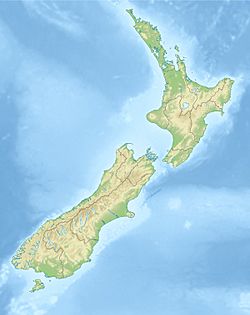1863 Hawke's Bay earthquake facts for kids
| UTC time | 1863-02 |
|---|---|
| Local date | 23 February 1863, 1:15 am NZDT (UTC+13) |
| Magnitude | 7.5 Mw |
| Depth | 25 kilometres (16 mi) |
| Epicenter | 40°00′S 176°30′E / 40.00°S 176.50°E |
| Areas affected | New Zealand |
The 1863 Hawke's Bay earthquake was a very strong earthquake. It happened near the town of Waipukurau in New Zealand on February 23, 1863. This earthquake was measured at 7.5 on the magnitude scale. It was the biggest earthquake to hit the Hawke's Bay area for a long time. That is, until a even stronger 7.8 magnitude quake hit in 1931. The 1931 earthquake caused a lot of damage in Napier and Hastings. Sadly, 256 people lost their lives in that later event.
Contents
Why Earthquakes Happen in New Zealand
New Zealand is a place where two huge pieces of the Earth's crust meet. These pieces are called tectonic plates. The two plates here are the Indo-Australian Plate and the Pacific Plate. They are always moving, but very slowly.
How Plates Move in New Zealand
In the South Island of New Zealand, these plates mostly slide past each other. This sliding happens along a big crack in the Earth called the Alpine Fault. It's like two cars driving past each other very closely.
In the North Island, the movement is a bit different. One plate slides under the other. This is called the Hikurangi Subduction Zone. But there's still some sideways sliding too. This sideways movement happens along a group of faults called the North Island Fault System (NIFS). This system runs from Wellington up through Hawke's Bay to Gisborne and the Bay of Plenty. Scientists believe the 1863 earthquake happened near the Mohaka Fault. This fault is just west of Waipukurau.
What Happened During the Earthquake
People living in Hawke's Bay during the 1863 earthquake reported many things. The ground shook so much that big chunks of land slid down hills. This is called a landslide. The ground also turned soft and watery in places. This is known as soil liquefaction. Large cracks, called fissures, opened up in the ground.
Inside homes, furniture fell over. Chimneys broke and bricks fell through roofs. Stores and hotels had a lot of damage to their goods. Even though some bricks fell, no one was seriously hurt. Some houses were even shaken right off their foundations. After the main quake, smaller shakes, called aftershocks, kept happening for hours.
Effects in Other Cities
The earthquake was felt far away from Hawke's Bay.
- In Wellington, many people woke up because of the shaking. Buildings had small damage, but many personal items were broken. One newspaper said the main quake lasted 30 to 40 seconds.
- In Wanganui, people said it was the strongest earthquake they had felt since a very big one in 1855. Luckily, no damage was reported there.
- In Nelson, people felt three quick, strong shakes around 1:20 AM.
- In Gisborne, the earthquake was felt, but it did not cause any damage.



